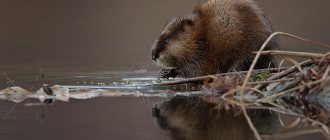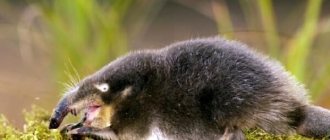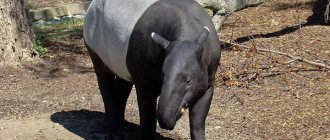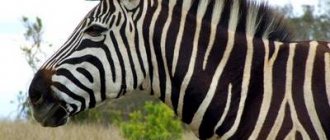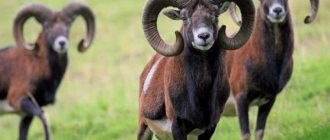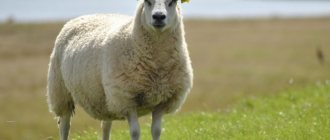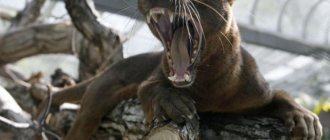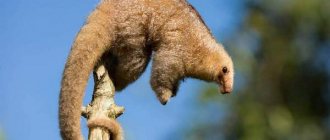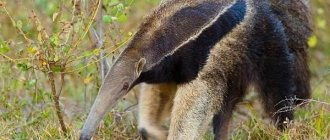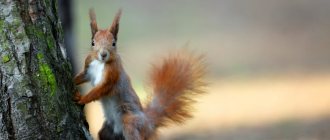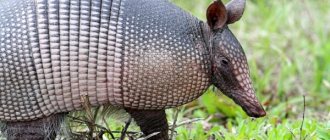04 October59300mustel family otterpredator pores
The river otter (other names: otter, common otter, otter) is a predatory animal that is a member of the Mustelidae family. The otter is a very interesting animal. The otter is an unsurpassed swimmer and skilled hunter; it is very dexterous and flexible. Below you will find a description and photo of a river otter, and you can also learn a lot of new and interesting things about this amazing animal.
general characteristics
All representatives of the species are quite large animals, which nature has endowed with a flexible, elongated, streamlined body. Thanks to this feature, otters swim perfectly both above and under water. On average, the body length, depending on the species, can be from 50 to 100 cm. The tail is from 20 to 60. The weight of adults is from 10 to 26 kg. Sexual dimorphism is weak, usually males are slightly larger and more massive than females.
Otters have short, powerful legs and have membranes between their toes. There are species with and without claws. The tail is muscular, covered with short fur, and does not fluff.
The head is round, like the whole body is streamlined, the mouth is slightly blunt. The ears are semicircular and small in size. A unique feature of otters is that underwater, the nasal openings and ears close, which allows the animals to feel comfortable while swimming and hunting.
The entire body of animals is covered with dense, waterproof fur. The thick undercoat perfectly insulates the otter’s body from moisture and hypothermia. In almost all species, the fur is brown or dark brown in color. Usually the lower part of the body is colored in lighter colors from beige and white to silver.
Otters do not store fat and do not hibernate. The only way to survive in cold weather is regular food and warm burrows. Therefore, if a reservoir runs out of fish, otters leave their usual areas and migrate in search of food.
Elena
Ask a Question
Question to the expert
What sounds can otters make?
The sound range of waterfowl is very diverse. Otters may hiss, snort, or chirp when scared. When communicating within a species group, they yap, squeak, squeal, and hoot. During a fight, animals howl or make sharp yapping sounds. Tamed otters use yelps and howls to beg for food or affection.
River Otter in the Red Book
Today, river otter populations have declined catastrophically across their entire habitat. Everywhere except the Australian continent, where otters are not found, they are taken under protection and listed in the Red Book.
In many countries where animals were widespread, it was not possible to preserve the endangered species. These include Switzerland, the Netherlands and Belgium.
Main causes of extinction
All over the world there is a fight against hunters who destroy huge numbers of mammals. Poaching is especially widespread in winter. The reason for this demand is the valuable animal fur.
Also, the development of the population is negatively affected by poor environmental conditions. People pollute water bodies and the number of fish decreases. Accordingly, the otter does not have enough food, which sometimes even leads to death. Many animals become victims of fishing nets. They get tangled in the gear and die.
Current population situation
Today, all types of otters are in the Red Book. In some areas, the mammal population is slowly but increasing. But overall the situation continues to be deplorable. The extermination of animals no longer occurs on such a scale. The authorities of all countries are constantly fighting for the existence of the species.
However, rivers, ponds and lakes are very heavily polluted by humans. Maybe if more people see what a cute otter with a perky disposition looks like, they will think about the problem.
What measures are taken to protect
The main measure in the fight to preserve an endangered species is to include it in the International Red Book. This is already a serious signal that it is urgent to take some action to restore the number of animals.
The next effective method is to organize special reserves or sanctuaries where endangered animals are bred. The wards are closely monitored, protected from predators and poachers, treated for diseases and fed.
Animals are kept in zoos, where favorable conditions for life and reproduction are created for them. Not all types of otters feel good in captivity, but most animals quickly get used to it and behave friendly.
Habitat
Waterfowl easily adapt to almost any place, the main condition is the presence of a body of water and fish. They can live in rivers, swampy lowlands, lakes, seashores and even in rice fields. Animals always settle near bodies of water, although they can move and hunt on land. Most species live near fresh water bodies; only two subspecies prefer salt water - the sea otter and the cat otter.
If for some reason life in the old place is impossible, otters migrate over quite impressive distances.
For the construction and arrangement of burrows, animals choose areas where there are many natural shelters and shelters.
Representatives of the species are found throughout European territory, Asia, Russia, South Korea and America.
On what continent do kangaroos live?
Kangaroos are found in Australia, Tasmania, New Guinea and the Bismarck Archipelago. Introduced to New Zealand. Most species are terrestrial, living on plains covered with dense tall grass and shrubs. Tree kangaroos have adapted to climbing trees; Mountain wallabies (Petrogale) live in rocky areas.
Interesting materials:
How to change Memoji stickers? How to change font style on Huawei? How to change your DNS server? How to change folder properties? How to change the theme on Instagram? How to change Samsung notification light color? How to change the time on a fitness bracelet? How to change the time on Samsung? How is atmospheric pressure measured? How to measure employee productivity?
What do they eat?
Recommended by topic
Fox Panda Lynx
The diet depends on the type and habitat of otters, but the basis is fish and other inhabitants of water bodies. One individual can eat about 10% of its own weight. For example, a giant otter can eat about 3.5 kg of fish per day, and smaller American representatives from 1 to 2 kg. It is noteworthy that otters eat small fish and crustaceans directly in the water, lying on their backs and holding the prey with their paws, while they prefer to drag larger fish ashore.
Diet:
- Fish: carp, pike, gobies, minnows, rotans, catfish, perch, roach, etc.
- Small rodents: water voles, rats, baby beavers.
- Insects: large caddisfly larvae, dragonflies.
- Small birds and chicks: ducks, waders, seagulls.
- Amphibians, crustaceans, reptiles and amphibians: frogs, lizards, snakes, toads, turtles, mollusks, crayfish, crabs.
The size of prey depends on the species.
For example, giant otters are the dominant predator in their habitat and hunt in groups. They can easily handle an anaconda or a caiman. Question to the expert
How long can otters stay underwater?
Otters are excellent swimmers and can spend 2 to 4 minutes underwater.
Nutrition
The otter's diet includes mainly fish, but they can also feast on shellfish, bird eggs, crustaceans and even some terrestrial rodents. is also no friend to the muskrat , which can easily end up with the predatory animal for lunch.
Otters spend a very large part of their lives in search of food; they are quite agile and fast. Due to their gluttony, their habitats must be fishy. This animal is a wonderful hunter, so after eating, the hunt does not end, and the caught fish act as a kind of toy.
Otters are of great benefit to fisheries, as they feed on non-commercial fish, which in turn eat eggs and fry. An otter eats about 1 kg of fish per day, with the small ones being kept in the water and the large ones being pulled out onto sushi. She feeds in water in this way: she places it on her stomach and eats.
After finishing the meal, it carefully spins in the water to cleanse the body of food debris. He is a clean animal. The animal does not respond to baits left by hunters, so it is extremely difficult to attract an animal in this way, unless it must be very hungry.
Lifestyle and character traits
The entire life of the species is inextricably linked with water spaces. The animals spend most of the day in their comfortable and protected houses, and at dusk they go out to hunt. In hot weather, otters leave their shelters and happily bask in the sun, lying on their backs in the water, or stretching out on a fallen tree.
Lifestyle
Representatives of the species prefer to settle in places rich in fish and other animal food. They often choose rivers with deep pools, channels littered with windbreaks and channels with non-freezing rapids. Otters can reach speeds of about 20 km/h underwater. On land, the animals move in small jumps and look quite funny.
The entrance to the main shelter is most often underwater, so it is impossible to get into the hole from the ground. Such structures are very difficult to detect, since the ground part is often hidden by grass and fallen trees.
They make burrows and shelters in thickets, windbreaks, and sometimes occupy small caves or crevices.
One individual can occupy a hunting area along the river from 5 to 15 km. The controlled coastal zone usually does not exceed 200-300 meters, since otters rarely go onto land in search of food. Animals hunt at depths of up to 3–4 meters. Most often, otters use the same routes from year to year, but it is very difficult to stumble upon a land path, since the animals travel most of the way by water.
If the pond freezes over in winter, the otter is forced to migrate in search of food over distances of 10 to 20 km per day.
On slopes and flat areas, animals leave interesting traces in the form of a groove. In such places, otters simply slide down the snow on their bellies so as not to waste time and energy.
It is noteworthy that such traces can be found in places where animals permanently live. In winter, young and adult animals ride on their bellies like downhill.
Otters are very secretive animals and rarely make their presence known. This often confuses researchers and makes it difficult to carry out protective measures. The only sure sign is piles of droppings on rocks and fallen trees. With their help, scientists can count the size of a group and calculate the population in a specific region.
Some researchers believe that otters use piles of droppings to mark their territory.
Character and habits
Most species strictly adhere to territory boundaries.
Typically, the areas occupied by males are much larger than the hunting grounds of females. Female otters have a calm disposition and calmly tolerate border violations. They often play with other females in shallow water and do not conflict. There are areas where several females live in separate burrows.
Recommended by topic
Heron Lynx Antelope
In contrast, males do not tolerate competitors and are very aggressive towards intrusion into their territory. Strong alpha males often take over promising areas and drive away weaker individuals. Fights between otters are quite serious and often end in injury or death. The losers try to quickly leave the conqueror’s territory and find a quieter area for themselves away from the dominant individual.
Each species has its own behavioral characteristics. For example, sea otters hunt alone, and during rest they gather in groups of 10 to 100 individuals.
- Asian great-clawed otters live and hunt in groups of 10–15 individuals, being active at night.
- Smooth-haired animals also form into groups, but go out hunting in the daytime.
- Southern river otters enjoy solitude and prefer to pair up only during the breeding season.
- Eurasian otters are distinguished by strict territorial customs and actively defend their fate not only from enemies, but also from relatives.
- Canadian otters are considered the most social representatives of the species. They gather in groups of 10 to 20, organize a common shelter, hunt in a group, and also raise offspring together.
- Giant otters, like Canadian otters, live in groups, but their families have a strict hierarchy in which the dominant pair is in the lead. They jointly defend their territory from enemies and other families.
Reproduction and raising of offspring
Most species lead a solitary lifestyle and pair up only for the breeding season. On average, the ability to reproduce occurs at about 2–3 years of age.
Unlike other members of the family, sea otters reach sexual maturity in females at approximately 4 years of age, and in males at 5 years of age.
Mating season
The mating period of species depends greatly on the climatic zone and the abundance of food. During times of food shortage, animals may delay their breeding season indefinitely.
For example, in warm regions rich in food, the mating season can last throughout the year, and in the middle zone from February to August. Canadian otters breed from December to April. In rare cases, a female can give birth to two offspring in a season.
During the breeding season, males leave their usual territory and go in search of a partner. Males actively fight among themselves for females; fights are quite brutal and can lead to injury or death of the opponent. The winner usually stays with the female for several days until she drives him away. Otters can mate both in water and on land.
Where do they live?
Various species of otters are found on every continent except Australia and Antarctica. The largest number of species is distributed in such natural zones as taiga, mixed and deciduous forests, dry and humid tropical forests.
Where live
Suitable habitat for the river otter is rivers and lakes located on the plain or in the mountains with clean water and sufficient food. You are more likely to find a predator's refuge in places with rapids, whirlpools, overgrown or windfall-covered banks. Animals living in cold climate zones select habitats near areas of rivers and lakes that do not freeze in winter.
Sea otters prefer coastal areas with rocky shores and no signs of human presence.
Natural enemies
Otters spend most of their lives in water, where there are few natural enemies. Animals are in much greater danger on land.
Natural enemies:
- alligators and crocodiles;
- killer whales, sharks;
- seals;
- cougars;
- caymans;
- wolves, coyotes;
- jaguars;
- the Bears;
- lynx;
- foxes;
- eagles and owls (prey on young);
- pythons, anacondas;
- domestic dogs.
Humans also play a significant role in the extermination of species. The animals are hunted for their fur and their natural habitat is destroyed.
Elena
Ask a Question
Question to the expert
How long does an otter live in the wild?
On average, otters live from 10 to 15 years. But there is information about centenarians who lived to be 20–25 years old. Scientists note that the average life expectancy of females in the wild is 3-5 years longer than that of males.
Interesting Facts
Otters are amazing animals that amaze with their unique features and cause affection with their appearance.
Interesting Facts:
- All representatives of the species see perfectly underwater.
- During a dive, the ears and nasal openings are closed.
- Otters are quite clumsy on land, but over short distances they can reach speeds of up to 35 km/h.
- Sea otters can hold their breath for 3–4 minutes; other species cannot remain underwater for more than two minutes.
- Animals can swim, lie down or sleep on their backs. They float on water thanks to their dense fur and thick undercoat, which does not allow moisture to pass through.
- If the water is cloudy, otters search for prey using sensitive whiskers (vibrissae).
- Otters have webbing between their toes.
- Otters sometimes catch more prey than they can eat at one time. Animals make reserves from “extra” products for the next day.
- Some species lack claws.
- Sea otters are very attached to their baby and simply do not let him out of their clutches. If the cub dies, the female does not part with the body for several days and mourns the loss for a long time.
Animal research continues to this day, since otters are quite secretive animals and are in no hurry to share their secrets.
Appearance
The river otter has a streamlined body shape, its length is from 55 to 95 centimeters, excluding the tail, which grows up to 55 centimeters. The animal weighs approximately 6 to 10 kilograms. The tail of the animal is not at all fluffy, but is equipped with a large number of muscles. The eyes are small, round, but located on the face so that the animal sees everything around very well. The animal has a thick neck.
The paws play a very important role for the river otter: they are short and webbed. The hind legs are longer than the front, this feature allows the otter to easily float on the water and swim quickly.
Otter jumping into the water
The fur of the animal below is colored silver or light in tone, but on the back and legs it is dark brown. The special structure of the hair allows the river otter not to get wet in the water. In spring and summer, the animal sheds, but the color does not change.
